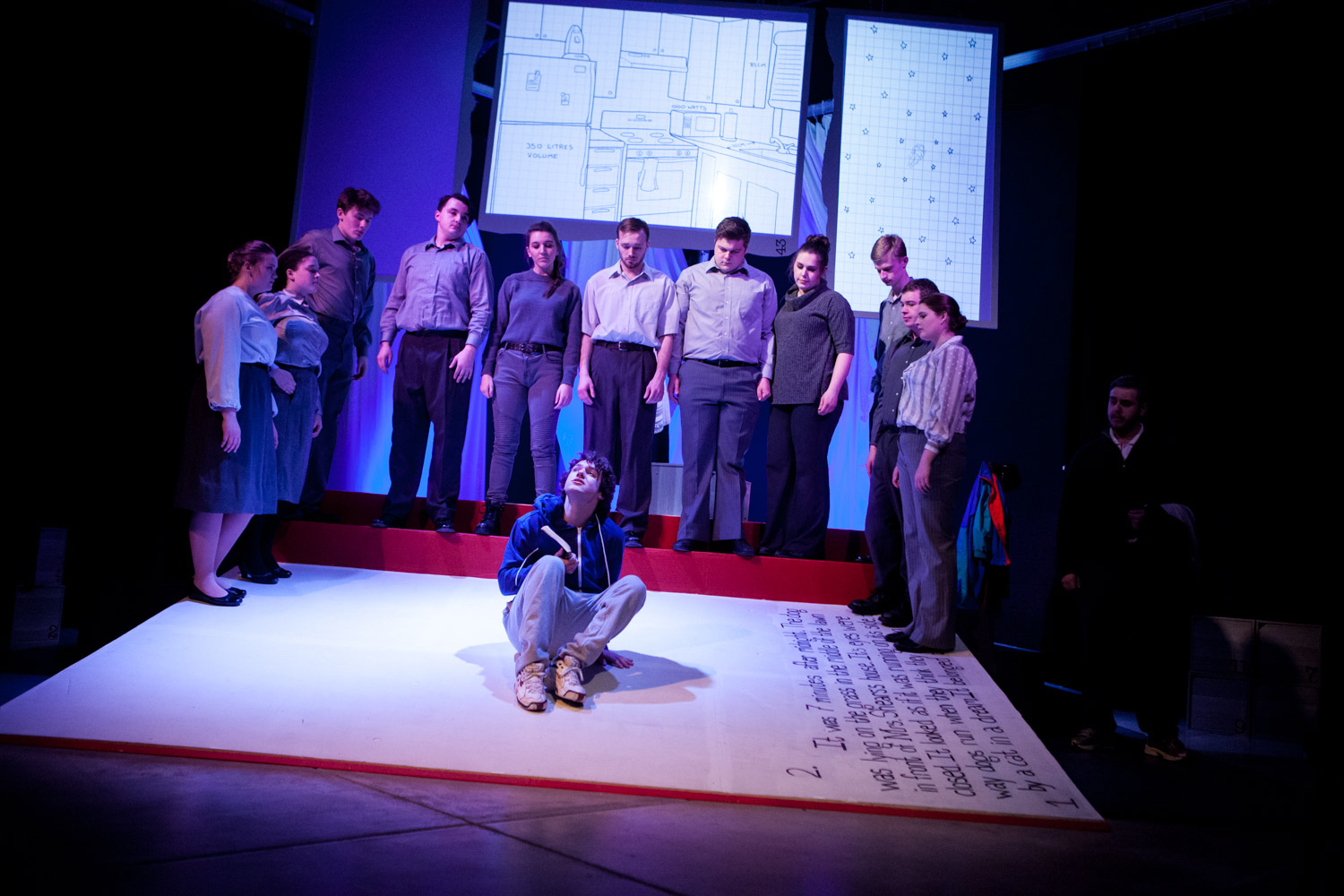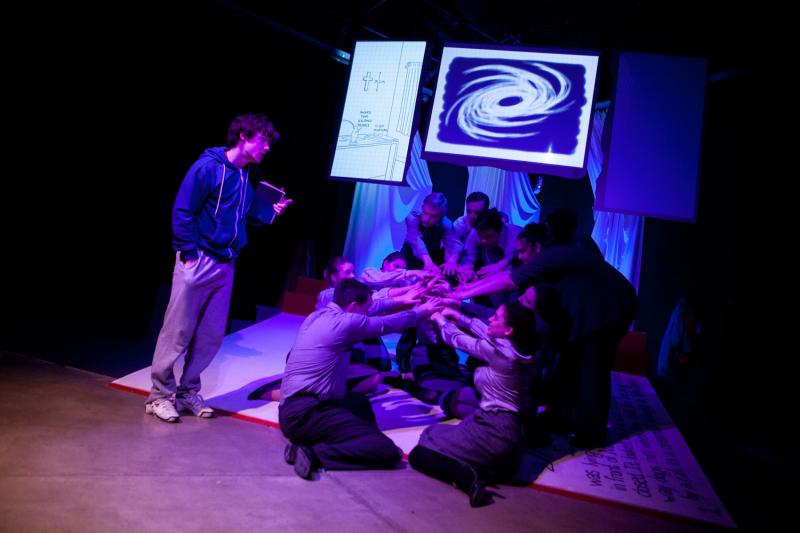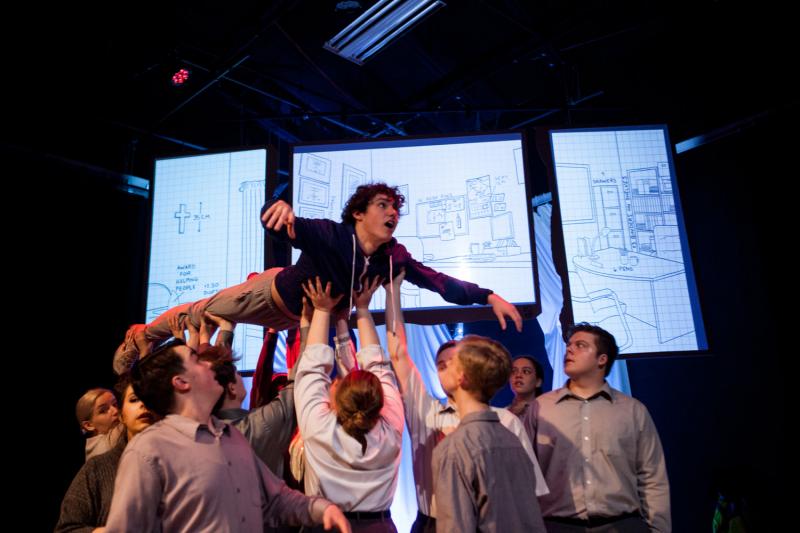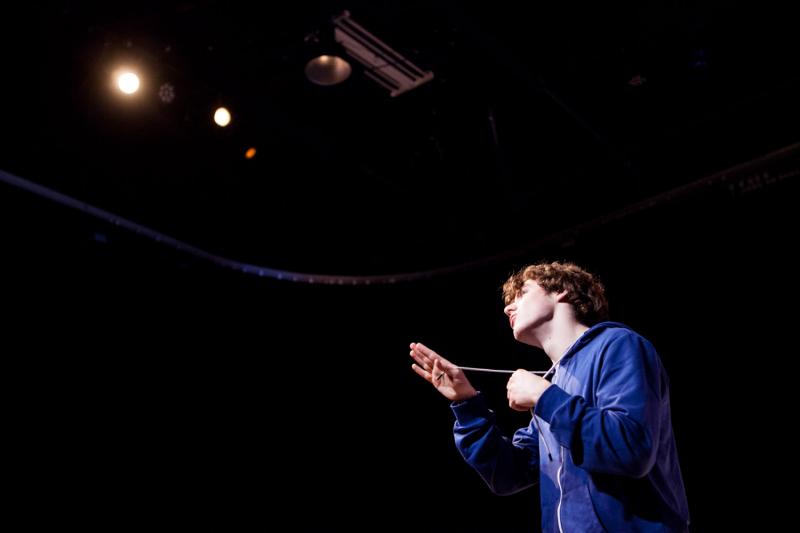Review: Left Curiously Emotional by THE CURIOUS INCIDENT OF THE DOG IN THE NIGHT TIME at Nebraska Wesleyan University Theatre

I've read the book. I've seen another excellent production of this story. But not until seeing Nebraska Wesleyan University Theatre's version have I actually been excited about THE CURIOUS INCIDENT OF THE DOG IN THE NIGHT TIME.
THE CURIOUS INCIDENT OF THE DOG IN THE NIGHT TIME originated with an award winning 2003 mystery novel written by British author Mark Haddon. Simon Stephens adapted the book for stage as a play within a play, changing from first person narrative to a narrator reading from the lead character's book. It won seven Olivier Awards before transferring to Broadway in 2014. There, the play captured a plethora of awards including the coveted Tony Award for Best Play in 2015.
The story is an odd but intriguing one. Christopher Boone is a 15 year old boy with an unspecified condition with manifestations similar to autism. He is exceedingly brilliant with numbers, minutiae, and observation, but is severely limited in his interpersonal relationships. Christopher lives with his father who tells him his mother has died. When the neighbor's dog, Wellington, is killed with a pitchfork, Christopher is their initial suspect. He is given a caution for assaulting a police officer in reaction to being touched, and he takes it upon himself to follow all clues until he finds the murderer. He finds more than clues. He finds another mystery involving his mother, which sends him on a terrifying solo journey to London on the train.
NWU put a new and different face on the story by cutting back the technology. They replaced the cold bells and whistles with humans. Each member of the cast was fully utilized as various characters, as props, as furniture, and even as sound effects that made for a nonstop whirlwind of a show.
The minimalist set included three panels hanging from the ceiling and some wooden blocks labeled with numbers. The ceiling panels were used as background for projected graph paper on which line drawings gradually appeared. Sketches of the bedroom and buildings were drawn with mathematical details added: 16 knobs on a dresser, a 60 watt lightbulb, a 35 centimeter cross. Projection engineers Zachary Bowen and Joseph Sanford IV along with Animation Designer Lee Bokma did some great work. The numbered blocks were carried by the members of the cast and repositioned into a storefront, a stairway that was assembled as Christopher ascended and descended, a bed, a group of classroom desks. The creativity of it all was fascinating.
People were used to express Christopher's confusion in the train station. They crisscrossed each other's paths calling out the words on signs you would commonly read such as advertisements for food. The auditory presentation demonstrated how Christopher's mind would perceive sounds connected with written words. Persons also became the trains. Carrying two flashlights to indicate headlights, they circled the platform as trains entered. Stopped. People entered. They jerked as the train started and departed. Another person enters. Stops. Jerks. Departs. The use of the cast was remarkable! Ryan Kathman did an incredibly fine job directing this complicated show with so much movement and detail.
Noah Jeffrey played a believable Christopher. Watching him reminded me of Freddie Highmore on the TV series, "The Good Doctor." His facial expressions, subtle mannerisms, and even his reactions to human touch or confusion were never over the top, but you could feel his turmoil. At the beginning of Act Two, Jeffrey solved a Rubik's Cube to Coldplay's "Fix You", then handed it to a member of the audience who changed it up. He sat down and solved it once again, totally bewildering me.
Jon Kava as his father Ed Boone and Erin Viets as his mother Judy were emotionally charged. I was shaken by their pain as they tried to connect to their son.
Olivia Ficke-Anderson (Mrs. Alexander), Madi Dodson (Mrs. Gascoyne), and Hannah Tewes (Punk Girl) stood out. Ficke-Anderson's elderly neighbor presentation was sweetly accurate. Tewes continually remained in character, not only as a punk girl, but as a member of the ensemble. Her stage presence is strong.
There is one scene that also stands out. The ensemble sits at their boxes representing school desks in a classroom. One person begins tapping a rhythm. Soon there's another, and another, and another with variations on the beat. Dodson sings along acapella in a very fine voice. The results are chilling.
I don't know what I can add to my response to this production other than "Bravo!" It may be a bit of an emotional review, but the show left me emotional. I loved every minute. To do so much using so little is inspirational. The simplicity, the smallness of the theatre with its personal feel, the multiple uses of each person in the cast...they all add up to a prime production.
Performance dates: April 11-13 at 7:30 pm; April 14 at 2:00 pm.
Photos courtesy of NWU Theatre.
Reader Reviews
Videos


